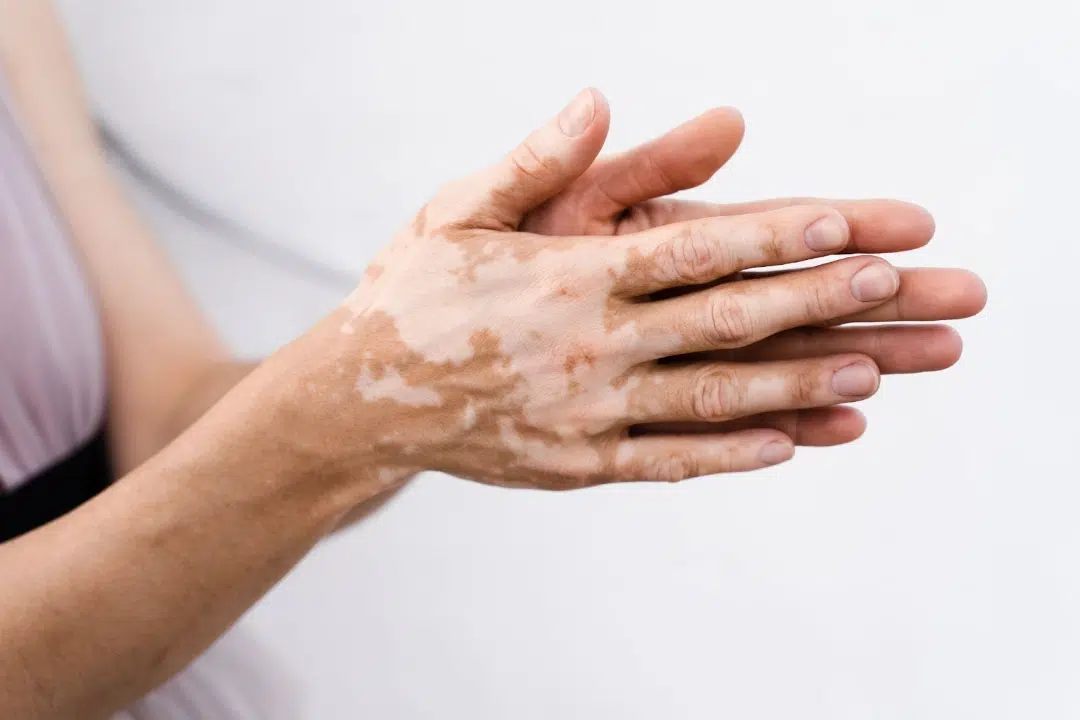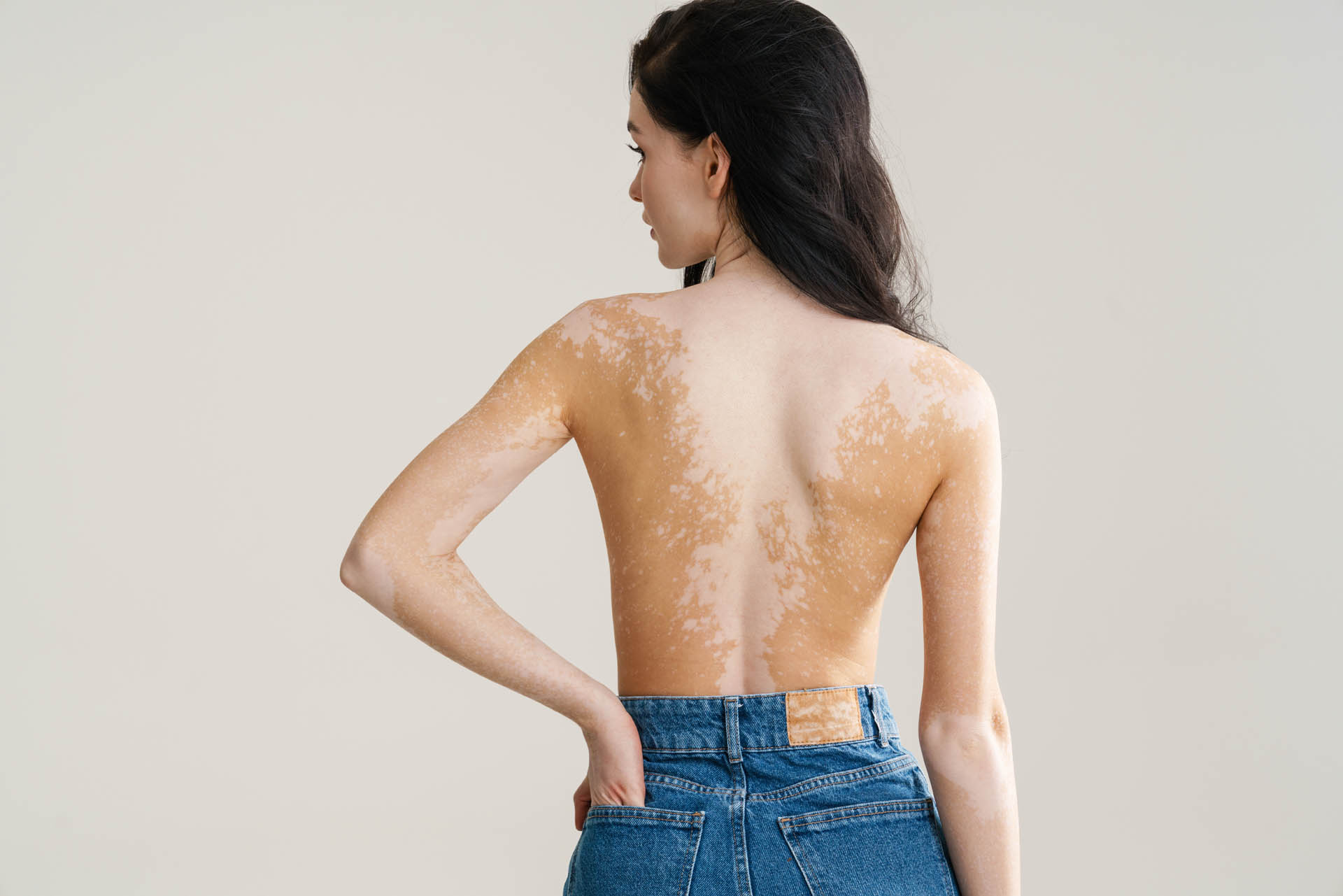
Vitiligo is a skin condition characterised by the loss of pigment of the skin. This condition affects about 1% of the population worldwide [1], and the psychological burden of vitiligo can negatively impact patients’ quality of life. Our experienced dermatologists offer expert care to help you understand and manage this condition effectively.
Vitiligo is an autoimmune disease whereby the body’s immune system attacks melanocytes, the pigment-producing cells of the skin. The result of melanocyte destruction is patches of depigmented skin, which are lighter in colour. These patches can grow bigger over time, or stop progressing.

Common misconceptions and misunderstandings about the condition contribute to the stigma surrounding vitiligo. Some of these include:
Vitiligo appears as a small patch of white or pale skin that may spread over time. Typically vitiligo appears as:
Other accompanying symptoms of vitiligo can also include:
Types of vitiligo
Vitiligo may appear or develop in different patterns on the body, loss of pigment in vitiligo can take the following forms [2, 3]:
Scientists believe that there may be genetic factors that contribute to the different patterns of vitiligo [2].
What causes vitiligo?
The exact mechanisms of vitiligo are not fully understood. It is believed that CD8+ T cells attack the melanocytes by producing the cytokine interferon-gamma (IFN-γ). IFN-γ release leads to increased T cell recruitment, causing a positive feedback loop that leads to gradual loss of melanocytes. The destroyed melanocytes also release antigens which are taken up by other immune cells. A special type of immune cells, referred to as memory T cells “remembers” the melanocyte antigens. Memory T cells contribute to the repeated attacks on melanocytes, inhibiting pigmentation of the skin and contributing to disease relapses [1, 2].
The disease is also associated with several factors including:
How is vitiligo diagnosed?
Generally, your dermatologist can diagnose vitiligo by visually inspecting the patches associated with the condition. Vitiligo diagnosis can be done in the dermatologist’s office with the following tests:
How is vitiligo treated?
You may choose to leave your vitiligo untreated, however the condition can be reversed with proper treatment if it causes significant distress. Common treatment options for vitiligo include:
Treatment of vitiligo can be done on active or stable lesions. In some cases, these different treatment modules can be combined. However, it is important to note that vitiligo is a chronic condition, and relapses and recurrences of depigmentation may occur even after treatment.
Can vitiligo be cured?
There is no cure for vitiligo, it is a chronic autoimmune condition that can progress further or relapse. However, various treatment options are available to control the symptoms or halt disease progression and repigment the skin.

The impact of vitiligo on your self-esteem cannot be ignored. Changes in your appearance and social stigma surrounding the condition are thought to contribute to poor self-esteem in vitiligo patients. A number of things can help with living with vitiligo:
Although a typically benign condition, loss of skin pigment in vitiligo can cause psychological distress in patients. Our dermatologist understands the impact vitiligo can have on self-esteem and body image. We provide support and guidance on effectively managing vitiligo, including treatment recommendations.
Schedule an appointment with us today for a comprehensive skin analysis and personalised treatment plan.

Can vitiligo go away?
Vitiligo is a chronic autoimmune condition, and is unlikely to go away on its own. In some cases, the patches can go away on their own, but there is no way of knowing whether the patches may go away or progress further. Treatment options are available to control skin depigmentation, as well as to repigment the depigmented lesions.
How common is vitiligo?
Vitiligo affects about 1% of the world’s population, people of any skin colour, race/ethnicity, or gender can develop vitiligo.
Does vitiligo cause skin cancer?
Vitiligo does not cause skin cancer. On the contrary, vitiligo was associated with a lower risk of skin cancers including melanoma and non-melanoma cancers. This is likely due to the overactive immune system in vitiligo, which may have a protective effect against melanoma [2]. However, vitiligo treatment using PUVA therapy is associated with an increased risk of skin cancers [1]. Hence, medical consultation is important in diagnosing the condition and choosing a suitable treatment according to your needs.
Whether you’re dealing with a specific skin concern or seeking to enhance your natural beauty, Livingstone Dermatology is here to guide you on your journey to healthy, radiant skin.
Schedule an appointment today and experience the Livingstone standard of care in a welcoming, professional environment.